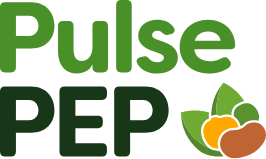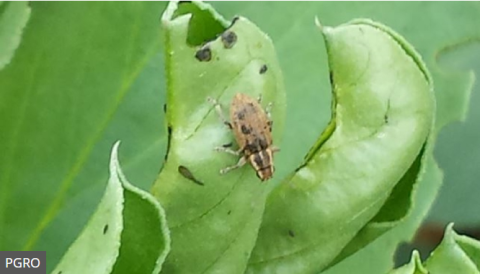In the spring, feeding adults can be a risk to newly emerged plants and can result in virus transmission, while larvae feeding on the root nodules is normally the main cause of yield loss.
Risk factors in peas and field beans
- Increased risk to crops near to leguminous plants or grassy margins in fields previously cropped with peas or beans
- Newly emerged crops are at risk from adult feeding during migration, which often occurs when the maximum air temperature exceeds 15°C
- Spring-sown and backward crops are at highest risk of damage
- Nitrogen-poor soil or drought conditions increase risk of larval feeding damage
Weevil identification
Scientific name: Sitona lineatus
Adults are 4–5 mm long and light brown, with faint creamy yellow stripes along the length of the wing cases. They have a short ‘snout’ with the ‘elbowed’ antennae typical of weevils.
Eggs are oval and white when laid but darken as they mature.
Larvae hatch legless and white with a brown head, reaching 4–5 mm in length when mature.
Pea and bean weevil life cycle and crop damage
Mar–May: Adults migrate into crops when temperatures rise above 15°C for short periods. Adult feeding damage is evident as notching around the leaf margins and is usually first noticeable at field edges.
Apr–Jul: Eggs are laid on, or around, crops and are washed into soil at the crop base.
Apr–Aug: Eggs hatch and larvae enter root nodules to feed.
Jun–Sep: Larvae move out of the root nodules and pupate about 5 cm below the soil surface.
Aug–Mar: Adults emerge and overwinter in grasses and leguminous crops, such as clover and lucerne.
Adults can transmit the Broad bean stain virus (BBSV) and the Broad bean true mosaic virus (BBTMV), which cause leaf malformation with light and dark green mottling and yellowish blotching. This can affect product quality and result in large yield reductions, if the infection occurs early.
Non-chemical and chemical control
Non-chemical control
Avoid cropping in areas that have previously had large pea and bean weevil populations. Natural enemies include spiders, ground beetles, rove beetles, predatory flies and parasitoids.
How to encourage natural enemies of field crop pests
Monitoring
A monitoring system that detects migrating adult weevils in early spring has been developed by Rothamsted Research with PGRO and ADAS.
Five cone traps containing pheromone lures should be sited on a single grassy verge or headland of a field that had contained peas or beans the previous year. The traps should be placed by mid-February and monitored three times a week until a threshold catch is reached, or until the latest-sown crops have emerged (whichever is the sooner). This system can identify periods of peak weevil activity and inform treatment requirement and timing, as well as optimum drilling time (i.e. to avoid periods of serious damage).
Thresholds
Spring-sown peas and spring field beans:
An average of 30 or more weevils per trap on any one recording day.
The crop may be at risk if the threshold is reached when the crop has just emerged or is due to emerge in the next ten days.
Insecticide resistance
Resistance to pyrethroids has been confirmed in the UK.




